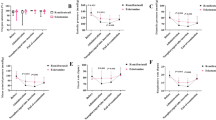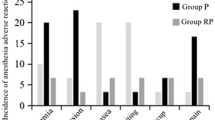Abstract
Aim & objective
To find if direct laryngoscopy (DL) could be done without using succinylcholine and secondly, to acertain the appropriate anesthetic regimen.
Patients and methods
In a double blind placebo controlled study 67 patients aged 40–75 years of age, of both sex requiring direct laryngoscopy (DL) either for diagnosis or for biopsy were enrolled. The patients were randomly divided in three groups. The patients in group F and S received Fentanyl or Sufentanil respectively along with Propofol, whereas those in group N received normal saline (placebo) and propofol. The conditions of laryngoscopy, hemodynamic parameters and any adverse events were recorded. Good or fair conditions for laryngoscopy were achieved in 91% (21), 87% (19) and 73% (16) of patients in groups F, S and N respectively (p < 0.05) in favor of group F and S. During DL arterial pressure and pulse rate changes were minimal when propofol was administered along with opioids, (group F and S) compared to group N where only propofol was used.
Results
No serious side effects were seen in the three groups. Hence by these findings we concluded that better conditions of DL are achieved during anesthesia with propofol and fentanyl and sufentanil alone. The opioids provided additional benefit of stable hemodynamics.
Similar content being viewed by others
References
Takayuki K, Kotari J, Noriyuki S et al (2004) A large epiglottis cyst removed under DL. Otolaryngology 76:44–46
Natalini G, Fassini P, Seramondi V et al (1999) Remifentanil Vs Fentanyl during interventional rigid bronchoscope under general anaesthesia and spontaneous assisted ventilation. Eur J Anaesthesiol 16:605–609
Parrot S, Servin F, Allary R et al (2002) Target controlled vs manually controlled infusion of propofol for direct laryngoscopy and bronchoscopy. Anesth Analg 94:1212–1224
Wiel E, Davette M, Carpentier L, Fayoux P, Erb C, Chevalie D and Vallet B (2003) Comparison of remifentanil and alfentanil during anaesthesia for patients undergoing direct laryngoscopy without intubation. Br J Anaesth 91:421–423
Billard V, Moulla F, Bourgain Jl, Megnigbeto A, Stanski DR (1994) Haemodynamic response to induction and intubation. Propofol/fentanyl interaction. Anaesthesiology 81(6): 1384–1393
Tagaito Y, Isono S, Nishino T (1998) Upper airway reflexes during a combination of propofol and fentanyl anesthesia. Anesthesiology 88:1459–1466
Manola M, De Luca E, Moscillo L, Mastella A (2005) Using Remifentanil and sufentanil in functional endoscopic sinus surgery to improve surgical conditions. ORL 67:83–86
Reisine T, Pasternak G (1996) Opioid analgesics and antagonistin: Goodman and Gillmans The Pharmacological Basis of Therapeutics, 9th ed. New York Mc Graw hill 521–555
Hirabayashi Y, Hiruta M, Kawakami T, Inouse S et al (1998) Effects of lightwand compared to direct laryngoscopy on circulatory responses to tracheal intubation. Br J Anaesth 81:253–255
Bruder N (2005) Hemodynamic changes during Laryngoscopy: Does it matter J. Postgrad Med 51:264–265
Adachi YU, Satomoto M, Higuchi H, Watanabe K (2002) Fentanyl attenuates the hemodynamic response to endotracheal intubation more than the response to laryngoscopy. Anesth Analg 95:233–237
Armstrong M, Mark LJ, Synder DS, Parker SD (1997) Safety of direct laryngoscopy as an outpatient procedure. Laryngoscope 107:1060–1065
Author information
Authors and Affiliations
Corresponding author
Rights and permissions
About this article
Cite this article
srivastava, U., Mishra, A.R., Sharma, S. et al. Anaesthesia for direct laryngoscopy with propofol and fentanyl or sufentanil. Indian J Otolaryngol Head Neck S 60, 314–316 (2008). https://doi.org/10.1007/s12070-008-0106-x
Published:
Issue Date:
DOI: https://doi.org/10.1007/s12070-008-0106-x




